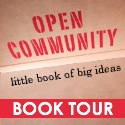I’m taking part in the virtual book tour and are doing to explore concepts from . Maddie and Lindy, along with their colleague Jamie Notter, have long been some of my favorite bloggers.

“Even though” they write about communications strategies, and focus on a very specific type of organization (associations), their ideas are big, broadly applicable, and eminently practical. I appreciate their deep sensitivity to the organizational and leadership challenges of communications, especially when applied to social media tools. So when Maddie and Lindy put their ideas together in a book, and set up a virtual book tour to promote their ideas, I was only too happy to sign on.
Knowing that this post would be one of the last in a long line of reviews (all of them positive, it turns out) I wanted to ask them questions that not only pertained directly to authenticity and organizations of all kinds, but also to ask them questions that they might not have already answered. Below, Maddie graciously answered my questions … even the completely softball opening question of:
“Why “Open Community“?”
Maddie Grant: We come from the association industry and for many of us “membership” people, community is old hat. It’s what we do. It’s central to our work.
And yet, for some reason (actually a lot of reasons) what we know about community isn’t always translating well to building community online. Lindy and I have talked to thousands of association executives who have voiced their frustrations about the social web–from the overabundance of tools and the disorderly experimentation of staff and members, to the lack of organizational support and the unwieldy processes for monitoring and managing social media, and that’s just the beginning. It’s easy to get bogged down in the newness and the detail, and miss the bigger picture–not the 10,000-foot bigger picture, but the “just high enough to make practical sense” bigger picture.
So we started writing the book, and the idea that kept popping up is the concept of Open Community. Here’s the gist: Your Open Community is your people who are bonded by what your organization represents and care enough to talk to each other (hopefully about you!) online.
Surprising Reactions and New insights
cv: All of the reviews of the book have been enthusiastic and positive. Certainly, you knew your book would address a ‘pain point’ or fill a need for association staffers and/or members, and the positive response to the book confirms that you’re offering associations something they feel they need. As you’ve read the reviews yourselves and talked to people who’ve read the book, which reactions have surprised you? Where there any points you took for granted (or thought were kind of banal) that resonated very strongly with readers? What new insights did you have about Open Community as you listened to readers?
Maddie Grant: Actually, we wrote (and promoted) the book very consciously as a “conversation starter” and every “big idea” in the book is meant to be something people can riff off of and build a bigger conversation around. So while we were more excited than surprised that i t has actually worked that way and sparked some great conversations, we were also amazed at the creativity of some readers in sharing their thoughts. Here’s an example — and filmed a little video spot talking about what resonated with them. 
On the downside, we’re looking for case studies from associations “living” the concepts in the book–and we’re sure they are out there–but everyone feels that they are behind the curve right now. So it looks like our industry may need this book even more than we thought, to help push things forward and help these organizations become more “social” and more open.
Aligning Actions and Purpose, and Conveying Meaning
cv: When I talk with organizations and their members, I focus on two issues–one is aligning actions with purpose, and the other is finding what’s most meaningful about the organization/business for members/employees and the organization’s external stakeholders. When you think about the insights and recommendations in Open Community, which single bit of advice do you think is most relevant to aligning actions and purpose? How about for helping associations and organizations communicate what’s most meaningful?
Maddie Grant: Great question. In a wide sense, the entire book is about conveying the meaning of the organization. You can’t successfully connect with your community online without being able to identify why that matters purpose and what you are trying to achieve. Maybe you’re trying to advance an industry or profession–every association mentions that in their mission. Or maybe you’re trying to achieve something more tactical, like reaching out to younger stakeholders or reinforcing an advocacy campaign.
And as for our single bit of advice: choose clarity over control. We define clarity over control as “a leadership concept in which the clear articulation of an organization’s most important priorities, universally understood by all stakeholders at all levels of the organization, de-emphasizes the need for centralized control over every detail of the organization’s activities.” We call it “the key to leading the way and sharing control.” In it’s simplest form, it means being able to define for everyone in an organization (staff and members) how online activity advances the mission of the organization. If you can do that, then you’re allowing not only your staff, but also your members and other stakeholders to share and collaborate in the work of the organization in
a strategic way.
cv: In the last several months, there have been several books trying to explain and help us anticipate how social media will push organizations to change, and how organizations might embrace social media to transform themselves and their relationships with their stakeholders. I’m thinking of books like Charlene Li’s , Tony Bingham & Marcia Conner’s , by Beth Kanter, Allison Fine, & Randi Zuckerberg, and The Dragonfly Effect by Jennifer Aaker and Andy Smith. Each of these books is focused on its own niche (leadership, learning, nonprofits, and social change, respectively) but all of them address the link between social media and serving a community.
Recognizing that you’re focused on associations, what insights from Open Community do you think apply to any organization and to every organization that wants an online presence?
 Maddie Grant: There are many lessons in the book for any kind of business. We actually feel that many associations have a huge advantage that they have yet to leverage–they have a built-in community within their membership. Association communities are people who gather in real life and talk about industry issues and spread the word or volunteer their time for the good of the order. The book is about helping associations translate that to building community online as well as offline. Many other kinds of companies and businesses are actually looking at membership-type models to build customer loyalty. And even for those that haven’t defined their business model in that way, similar lessons apply because successful use of social media tools has everything to do with building relationships between people. For-profit companies may not have built-in communities, but the smart ones are aware that the power of social media lies in the growth of networks around brands and organizations.
Maddie Grant: There are many lessons in the book for any kind of business. We actually feel that many associations have a huge advantage that they have yet to leverage–they have a built-in community within their membership. Association communities are people who gather in real life and talk about industry issues and spread the word or volunteer their time for the good of the order. The book is about helping associations translate that to building community online as well as offline. Many other kinds of companies and businesses are actually looking at membership-type models to build customer loyalty. And even for those that haven’t defined their business model in that way, similar lessons apply because successful use of social media tools has everything to do with building relationships between people. For-profit companies may not have built-in communities, but the smart ones are aware that the power of social media lies in the growth of networks around brands and organizations.
So specifically, there are lessons in the book that are absolutely relevant to any organization: lessons about building internal capacity (process and structures) for successful social media management; about how to manage the relationship between public outposts (like Facebook, LinkedIn, Twitter) and your homebase website; about recognizing and rewarding champions; about new skill sets for becoming a social organization; and more. The ultimate lesson in the book is that building community online is about people, not about technology or tools.
Read this book!
CV: My own view of Open Community is that it hits the issues square in the center, and offers actionable advice for managers who want to use social media to cohere their stakeholders around a sense of shared purpose.
I’d recommend this book to practicing managers, but I also think it would be worth a read by academics. Although Open Community isn’t an academic book about organizational theory per se, the insights and suggestions are well-informed. I can imagine management professors reading this and getting a double whammy– actionable advice to offer students, and an orientation to what’s really going on in actual organizations run by real managers who care about what they do and the people they do it for. I’d also assign this book to BBA, MBA and ExecEd students, because Maddie & Lindy reinforce all the messages we want students to hear about communicating and leading– in a very real-wold way. While Open Community will orient any manager to the key issues of social media, it really is a primer on the leadership challenge of creating community- online and offline.
More on SocialFish :
:
Mobile apps are a waste of time for associations, by Lindy Dreyer
Do you have a philosophical commitment to becoming social?, by Maddie Grant
Social Organizations Are Inclusive, by Jamie Notter
[Disclaimer: I liked this book enough to buy my own copy; I didn’t get a free book in exchange for a post. I’d have read Open Community anyway, and appreciated it just as much. ]
 I am an organizational consultant, change advocate, and organizational identity/reputation scholar with a PhD in leadership & organizations. I research, write about, and consult with organizations on the relationships between organizational identity, actions, and purpose. I teach Technology Management, part-time, at Stevens Institute of Technology.
My current research focuses on how social technologies in the workplace can drive organizational change, generate meaning, and catalyze purpose. See the
I am an organizational consultant, change advocate, and organizational identity/reputation scholar with a PhD in leadership & organizations. I research, write about, and consult with organizations on the relationships between organizational identity, actions, and purpose. I teach Technology Management, part-time, at Stevens Institute of Technology.
My current research focuses on how social technologies in the workplace can drive organizational change, generate meaning, and catalyze purpose. See the 
Comments on this entry are closed.